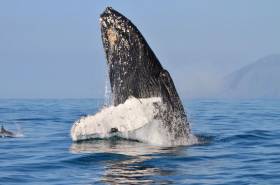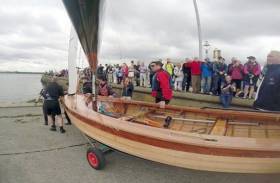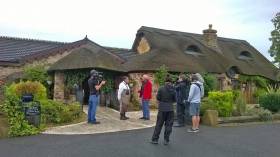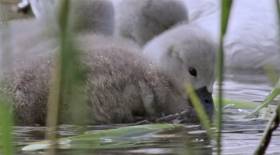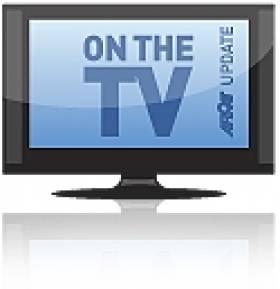Displaying items by tag: TV
Marine Wildlife Wows Viewers In New TG4 Documentary
#OnTV - A documentary on the wildlife of Ireland’s West Coast that’s wowed TV viewers during Seachtain na Gaeilge is now available to watch online.
As Independent.ie reports, the two-part Éire Fhiáin has been compared to Blue Planet for its incredible footage — from the Skelligs and Blasket Islands in the first episode to the rugged charms of Connemara and Mayo this past week, among other breathtaking locations.
Director and presenter Eoin Warner and his team used some of the latest filmmaking technology, including night-vision lenses and slow-motion cameras, to capture Ireland’s marine wildlife – and their land-lubber friends – like they’ve never been seen before.
And the results saw the hashtag #EireFhiain take off on social media last week — though if you missed the Irish-language series first time out, you still have time to catch up by streaming it via the TG4 Player.
Cape Verde Humpback Whales Doc On TG4 This Weekend
#MarineWildlife - Irish-made documentary The Humpback Whales of Cape Verde will be broadcast this Saturday 29 October at 7.15pm on TG4.
Narrated by Liam Ó Maonlaí and shot in Cape Verde, Ireland and Malta, the film follows Dr Simon Berrow of the the Irish Whale and Dolphin Group (IWDG) and an international team of marine scientists on an ambitious adventure to prove humpback whales from both the northern and southern hemispheres use the Cape Verde archipelago as a breeding ground.
“If we could make the connection, our understanding of humpback whale behaviour in the Atlantic would change,” says Dr Berrow. “Such a breeding ground would be unique. But going there in the first place at that time of year and at significant cost was a big if in itself.”
The lecturer at GMIT also believes the film will help highlight the importance of conservation in Irish waters.
“It still comes as a surprise to many that we have whales in Ireland,” he says. “In fact the numbers here are increasing each year and Ireland is becoming internationally important.
“To understand where whales in Ireland are coming from or going to and breeding is essential to protect them. This film is part of a 12-year search for the breeding grounds of humpback whales in Ireland.”
The broadcast on TG4 this weekend coincides with the 25th anniversary of all Irish waters being declared a whale and dolphin sanctuary, the first of its kind in Europe.
“It is an international story with an Irish perspective,” says director Tony Whelan. “It’s a cracking tale. Spending time with these scientists in an extraordinary environment was a privilege. We hope people enjoy it.
“We are really happy it has been taken up by TG4, an important channel for independent filmmakers. Without them stories like this can go unseen.”
The Humpback Whales of Cape Verde was screened around the country earlier this year as part of a library tour, as previously reported on Afloat.ie.
See New IDRA 14 ‘Wicked Sadie’ On RTÉ’s Nationwide Tonight
#OnTV - Clontarf’s new-build classic wooden dinghy Wicked Sadie will feature on RTÉ One’s Nationwide programme this evening at 7pm.
Nationwide’s team spent two days filming ‘Number 166’ and the build crew, both on the water and off, before her official maiden sailing.
The IDRA 14 was launched this past June after a three-year-long project by the Clontarf Yacht & Boat Club team, as previously reported on Afloat.ie.
“Wicked Sadie couldn't have come into existence without the physical and moral support of so many,” said the build crew in a statement, as they encouraged supporters to tune in and “see the results of all of your hard work and incredible support”.
Watch Nationwide this evening (Wednesday 26 October) at 7pm on RTÉ One to see the sneak peek of Wicked Sadie as she readied for launch.
But not to worry if you miss it as the programme will be available later for catch-up on RTÉ Player for the next 30 days.
Bobby Kerr’s Travels Along Home Shores Begin This Thursday
#OnTV - The first episode of Bobby Kerr-fronted UTV Ireland series Along Home Shores comes this Thursday 27 October at 7.30pm and explores Dublin’s waterways, with a visit to the famous wallabies of Lambay Island.
Afloat.ie reported last month on filming for the new eight-part-TV series, in which the Insomnia café entrepreneur and avid sailor will discover the hidden treasures of the coastlines and waterways of Ireland.
In each episode, Bobby will examine how people are using the natural resources of our waterways to create employment, while also showcasing the beauty of Ireland along the way. Over eight weeks, he will embrace the heart of maritime communities all over Ireland.
The first episode sees Bobby beginning his journey on his own doorstep of Dublin, where he goes for an early morning swim at the Forty Foot with members of the Sandycove Bathers Association.
At Grand Canal Dock, he meets a local leisure business and tries paddle boarding for the first time, and Bobby's fitness is put to the test when cancer support group, the Plurabelle Paddlers, bring him dragon boat training.
Eugene Garrihy, the owner of Dublin Bay Cruises, invites Bobby on board his boat to talk business, and he also gets an exclusive invite to the hidden gem of Lambay Island by businessman Michael Bermingham, who is the only supplier of Lambay meat in Ireland.
"I have been truly amazed by the scenic beauty of Ireland's coastline and inland waterways during my filming of Along Home Shores,” said Bobby of his experience making the series.
“The fascinating characters I met along the way were an absolute inspiration to me. Through the prisms of heritage, business and culture, I have now gained a unique insight into Ireland. The sheer magnificence of our coastal and inland waterways, and their people, cannot be overstated."
Beginning his voyage in the capital, Bobby will bring the personality of coastal towns, villages and inland waterways to life as he travels anticlockwise around Ireland before ending his journey back in Dublin.
Future weeks will see him visiting Rathlin Island's seabird colony, kayaking the Causeway Coast, angling on Lough Erne, sailing on Lough Derg, attending the homecoming of Skibbereen's Olympic heroes, cycling the Deise Greenway, going oyster farming, staying overnight in a lighthouse and lots more.
The first episode of Along Home Shores airs this Thursday 27 October at 7.30pm on UTV Ireland.
New TV Series To Highlight Lives On Ireland's Waters
#OnTV - Filming has commenced for the new UTV Ireland programme Along Home Shores.
The eight-part TV series is focusing on the waterways of Ireland, with each show examining inland, coastal and offshore lives in a different region of the country.
Taking the helm is Newstalk presenter Bobby Kerr, best known for his coffee chain Insomnia and his role as an investor on Dragon's Den.
As he travels the country, Kerr is meeting locals and businesses who live, play and work on the waterways.
So far the crew have made their way along the Lower Bann, the Grand Canal, Lough Erne and more recently along the Shannon, stopping in Carrick-on-Shannon and Lough Key Forest Park in Boyle.
The eight-part series will air Monday nights on UTV Ireland later this autumn.
Ireland's Urban Marine Wildlife Revealed In New RTÉ TV Series
#WildCities - From the producers of Ireland's Wild River comes a new TV series for RTÉ One revealing the wildlife – marine and otherwise – that make their home in Ireland's biggest cities.
Wild Cities premieres on Sunday 8 May at 6.30pm with a visit to Galway, where cameras follow wild salmon leaping the weir, cygnets taking their first dip at the mouth of the Corrib and otters frolic in the city's canals.
The following week the programme takes a trip to Dublin, meeting frogs in back gardens and herring gulls on city centre rooftops, while subsequent episodes in Cork and Belfast will reveal herons begging for scraps from market stalls, basking seals and darting kingfishers among many others.
#WorldSailing - World Sailing has announced plans to take the sport to a mass audience in 2016 at the London Boat Show.
Live broadcasts from three Sailing World Cup events will be bolstered by a new television series produced in conjunction with Sunset+Vine titled World Sailing.
The 26-minute monthly programme will deliver international news and highlights from medal races at World Cup regattas in Miami, Hyères and Weymouth and Portland, which will also be broadcast online around the world.
Rio 2016 is set to be the biggest Olympic sailing competition ever, and many of the potential medallists will be on show at the World Cup regattas in the build-up.
More than 10 major global broadcasters have pledged to bring live Olympic class sailing to their audience and "generate national heroes", according to the former ISAF.
Fans around the world will also be able to tune into the World Sailing TV YouTube channel.
And over 20 broadcasters worldwide have been confirmed for the highlights programme, which begins this month with an editorial focus on the build-up to the Olympics as well as coverage, personality features, background stories and news from the cutting edge of the sport.
Before that, World Sailing has today (Friday 8 January) relaunched its website at sailing.org providing a cleaner presentation that's intended to be easier to navigate.
"In order to take sailing forward in 2016, a pivotal year for sailing with the Olympic Games on the horizon, a new approach and fresh ideas with the fan experience at the heart was required for the governing body's website,” said World Sailing's chief marketing officer Malcolm Page.
"Social media is key for us to communicate directly with our audience across multiple platforms. With engaging content, increased interaction and regular video content on sailing.org we will be able to keep our worldwide audience continuously up to date in our evolving sport.”
The relaunch of sailing.org comes in the wake of the world governing body's rebranding from the International Sailing Federation (ISAF) to World Sailing last month, as previously reported on Afloat.ie.
'Tested on Humans' Duo Face Lifeboat Freefall & Helicopter Escape At NMCI
#NMCI - The National Maritime College of Ireland features on tonight's episode of RTÉ 2's new TV series Tested on Humans.
Tune in at 9pm this evening (Monday 14 December) to see presenters Claire Tracey and Keith Walsh find out what it's like to escape from a simulated helicopter crash underwater.
On their recent visit to the college's €90m training facility in Cork Harbour, the duo also faced the freefall lifeboat drop – a standard test for all modern ships but a challenge to beat any extreme theme park ride.
See more of Claire and Keith's antics testing their minds, bodies and nerves on RTÉ Player.
#OnTV - A boatbuilding project on the shores of Lough Ree will feature in a segment of tonight's Nationwide on RTÉ One from 7pm.
The 'Mens Shed' scheme for the Lanesborough-Ballyleague area – as part of a job activation and family support initiative for the twin towns – brought together 14 men to learn the craft of boatbuilding.
And the results are more than impressive, with the team building four new boats in just 25 days – a "huge success" in the words of Ballyleague-Lanesborough Area Mens Shed chairman Joe Cribbin
He hailed the scheme as preserving traditional arts and crafts for a new generation.
"On this occasion, as the lads continue their voluntary work in painting the boats, we would like to thank each and every person who supported this project in any way.
"Our special thanks to Anthony Dockery of Roscommon Integrated Development Company and Bernie Morris of the Department of Social Protection, Ted and Sheila Falvey, Lanesborough Community College and Waterways Ireland."
Cribbin added that it's hoped two of the new boats will be ready to be blessed and launched by the June Bank Holiday weekend – Sunday 31 May at 2pm at the Ballyleague Waterways Ireland harbour slipway.
Link to the programme HERE.
Hector Goes Fishing In First Of New Four-Part Series
#OnTV - Hector Ó hEochagáin returns to our screens tonight with a new four-part series of Hector Goes, beginning with a spot of fishing in Ireland's coastal waters.
Getting his orange combi van back on the road, Hector explores the quirkier side of Irish life as he immerses himself with some of the men and women who fish our waters - and sometimes risk their lives to put food on our table - but who are mostly anonymous to the rest of us.
As he heads out to sea with some real characters, Hector will get down to the nitty-gritty of fishermen's lives and concerns, and even make contact with some of our European neighbours fishing near our waters.
Hector Goes Fishing is broadcast tonight (Monday 3 March) at 9.35pm on RTÉ One and will later be available to watch on demand via the RTÉ Player.



























